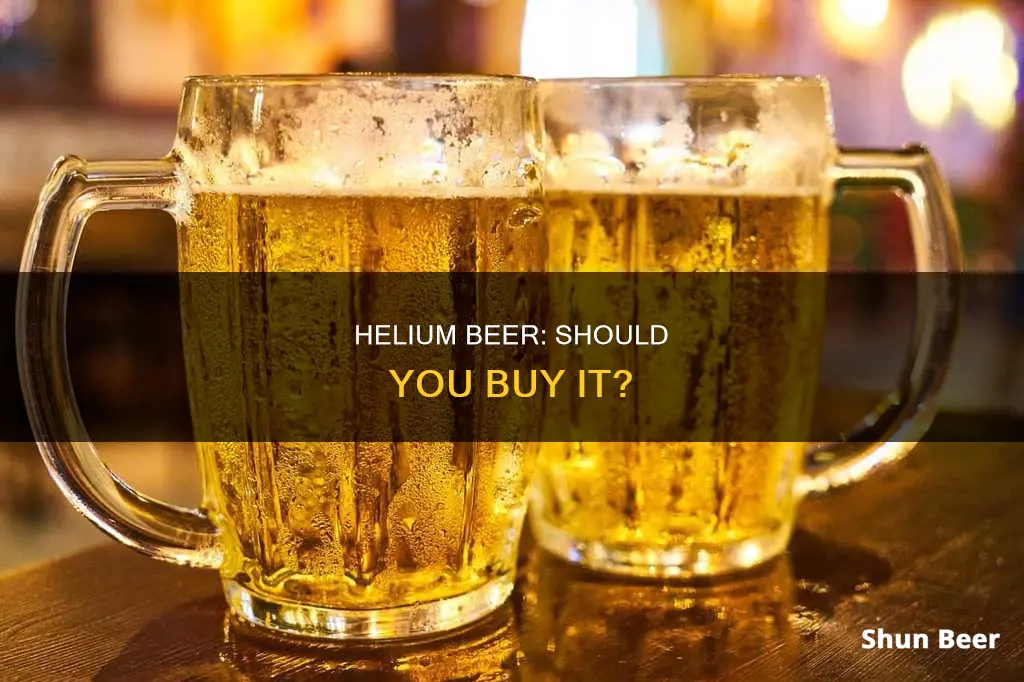
Helium beer has been the subject of many viral videos and online searches, with people eager to try this unique brew. The concept of helium-infused beer first gained attention in 2014 when the Boston Beer Company's Samuel Adams brand released an April Fool's video announcing the release of HeliYum, a beer with a light mouthfeel and odourless gas that doesn't compete with the natural aromas of its ingredients. This sparked a trend, with other breweries such as Stone Brewing, Berkshire Brewing Company, and Die BierProbierer following suit and releasing their own versions of helium beer promotions, also as April Fool's jokes. However, the question remains: is helium beer real, and can you buy it?
| Characteristics | Values |
|---|---|
| Is helium beer real? | No, it's not possible to create beer infused with helium. |
| Is helium beer just an April Fool's prank? | Yes, the videos of helium beer were pranks. |
| What companies have released videos of helium beer? | Sam Adams, Stone Brewing, Berkshire Brewing Company, and Die BierProbierer. |
| Is it possible to brew helium beer? | Technically, yes, but it's not advisable as it would result in a block of beer-coloured ice and wouldn't change the pitch of your voice. |
What You'll Learn

Helium beer is an April Fool's joke
Helium beer is not real and the concept was an April Fools' joke. On April 1, 2014, the Boston Beer Company's Samuel Adams brand released a video announcing they had created HeliYum, a beer infused with helium. The video was professional and founder Jim Koch committed to the joke, making it easy to believe. However, the video was an April Fool's prank, with the date being the only indicator.
In 2015, German YouTube channel Die BierProbierer also posted a video claiming to have tested helium beer. This was also an April Fools' joke, as it was also posted on April 1.
Other companies have also joined in on the prank. On April 1, 2014, Stone Brewing released a satirical ad for "Stochasticity Project Cr(He)am Ale with Helium". The same year, Berkshire Brewing Company produced an ad for a Helium IPA.
The idea of helium beer is not possible as helium is not soluble in water and it turns from liquid to gas at -220°F, freezing the beer. Helium is about 700 times less soluble in water compared to carbon dioxide.
Guinness Beer: Where to Buy and Enjoy a Pint
You may want to see also

It's impossible to infuse beer with helium
Helium also turns from liquid to gas at -220°F, which is cold enough to freeze pure alcohol. So, if you tried to infuse beer with liquid helium, you'd end up with a block of beer-coloured ice.
The idea of helium beer originated as an April Fool's prank by the Boston Beer Company's Samuel Adams brand in 2014. They released a video announcing the launch of HeliYum, a "radical, extreme new beer that leverages the wonderful properties of helium". The video sparked a trend, with other breweries, including Stone Brewing and Berkshire Brewing Company, releasing their own versions of helium beer promotions.
Despite the scientific impossibility of infusing beer with helium, some people have attempted to create helium-infused beer. For example, the team at Chemical & Engineering News (C&EN) tried to force "heliumnate" a stout beer by subjecting it to 50 psi of helium pressure for five days. However, the result was unchanged voices and a stout that looked and tasted like a regular stout.
Utah Beer Buying Hours: Time Restrictions Explained
You may want to see also

Helium beer videos are pranks
It is understandable that people would be curious about helium beer videos, given the popularity of craft beer and the desire to experiment with new and unusual brews. However, it is important to note that the videos claiming to showcase helium beer are, in fact, pranks or April Fools' jokes.
The idea of helium beer gained traction in 2014 when multiple companies, including Samuel Adams and Stone Brewing, released satirical videos and press releases announcing their "innovative" helium-infused beers. These videos were cleverly produced and even included professional figures, such as Jim Koch, the founder of Sam Adams, to add a touch of authenticity. The videos typically featured individuals drinking the "helium beer" and then speaking in high-pitched voices, mimicking the effect of inhaling helium.
The videos sparked a lot of interest and excitement, with people eager to try this unique brew. However, the claims made in these videos were soon debunked by scientists and beer experts. The key issue is that helium is not soluble in water or beer. Additionally, helium has a very low boiling point, turning into a gas at -220°F, which would result in frozen beer.
Despite the scientific impossibility, the pranksters behind the Die BierProbierer podcast kept the joke going by releasing a German-language "review" of the fictional Sam Adams helium beer. This sparked further interest and confusion, with people still wondering if helium beer could be a reality. While it is technically possible to force helium into beer, as demonstrated by the team at Chemical & Engineering News, it does not dissolve and would not have the purported effect on the drinker's voice.
So, while the videos of people speaking in high-pitched voices after consuming helium beer are entertaining, they are indeed pranks and should be taken as lighthearted jokes rather than serious product promotions.
Thanksgiving Beer Run: Augusta, GA Edition
You may want to see also

Helium beer is possible, but unlikely to be sold
Helium beer has been the subject of numerous April Fool's pranks by breweries, with videos of people drinking helium-infused beer and speaking in high-pitched voices going viral on YouTube. These videos sparked widespread interest and excitement, with many people eager to try this unique brew. However, the reality is that helium beer, while technically possible, is unlikely to be sold or commercially available anytime soon.
The main challenge in creating helium-infused beer lies in the fact that helium is not soluble in water. Unlike carbon dioxide or nitrogen, which are commonly used to carbonate beers, helium does not naturally bind to water molecules. Additionally, helium has a extremely low boiling point, turning from liquid to gas at -220°F, which would result in frozen beer.
Despite these hurdles, scientists from Chemical & Engineering News (C&EN) conducted an experiment to create a helium-infused beer. They replaced the carbon dioxide typically used in beer carbonation with helium and discovered that the helium piggybacked on the naturally occurring carbon dioxide, resulting in larger and faster-rising bubbles. The resulting beer, a milk stout similar to Guinness, had a creamy head and a smooth mouthfeel. However, it lacked the bubbly texture of traditional carbonation, and most importantly, it did not affect the pitch of the drinkers' voices.
While the C&EN experiment proved that helium beer is technically possible, there are several practical and commercial considerations that make it unlikely to be sold. Firstly, the unique properties of helium would create a mess when opening the beer, as the undissolved gas would escape quickly, causing a lot of beer to spill out. Secondly, the flat nature of the beer, due to the lack of carbonation, may not appeal to most beer drinkers who enjoy the fizz and bubbly texture. Finally, the high cost and limited supply of helium may deter breweries from using it in their beer production.
In conclusion, while helium beer may be possible from a scientific perspective, it is unlikely to be sold or commercially viable due to the challenges in creating a stable, appealing product, along with the high cost and limited supply of helium. So, for now, people will have to stick to traditional beers and helium balloons for their high-pitched voices.
Where to Buy Beer in West Virginia?
You may want to see also

Helium beer won't change your voice
The idea of helium beer first came about in 2014 when the Boston Beer Company's Samuel Adams PR team posted an April Fool's video announcing the release of HeliYum, a "radical, extreme new beer that leverages the wonderful properties of helium". The video showed founder Jim Koch taking a sip of the helium-infused brew and proceeding to describe its taste in a high-pitched voice. This sparked a lot of interest, with many people eager to get their hands on this unique brew.
However, the reality is that helium beer is not possible to create. This is mainly because helium is not soluble in water, and it turns from liquid to gas at -220°F, resulting in a block of beer-coloured ice. In addition, even if helium was forced into the beer and sealed in a can, it would be useless as the gas would escape very quickly as soon as the seal was broken, creating a mess.
Despite the scientific impossibility, the team at Chemical & Engineering News (C&EN) decided to experiment with creating helium beer. They used a stout beer and subjected it to 50 psi of helium pressure for five days. The result was a creamy, stable beer with a smooth mouthfeel, but importantly, the pitch of their voices and belches was unaffected.
So, while the idea of helium beer is certainly entertaining, it is nothing more than a prank and will not change your voice.
Buying Beer Early: King Soopers' 7am Policy Explained
You may want to see also
Frequently asked questions
No, you cannot buy helium beer. It does not exist.
It is not possible to create beer infused with helium. Helium is not soluble in water and it turns from liquid to gas at -220°F, which would result in a block of beer-coloured ice.
On April 1, 2014, the Boston Beer Company's Samuel Adams brand released a video announcing the release of HeliYum, a helium-infused beer. On the same day, Stone Brewing released a satirical ad for Stochasticity Project Cr(He)am Ale with Helium. These videos were inspired by a 1994 hoax email about a hydrogen-infused beer by the fictional Asaka Beer Corporation.
The people in the videos spoke in the high-pitched voice associated with inhaling helium after drinking the beer.
Scientists at Chemical & Engineering News (C&EN) experimented with forcing helium into beer. They found that although the helium did not dissolve, it piggybacked on the carbon dioxide occurring in the beer naturally, making the bubbles bigger and faster-rising. However, the pitch of their voices and belches was unaffected.







